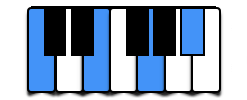Jazz is almost always 'homophonic' (‘n’, not ‘b’...). This is just a fancy way of saying that Jazz consists of two parts:
- Jazz Chords (Harmony); and
- Improvisation (Melody).
All other aspects of Jazz (chord extensions, scales, chord progressions, chord voicings, harmonic function, 'comping, reharmonisation, etc.) relate to either one of these two categories.
To facilitate my teaching, I have further subdivided the above two facets of Jazz into theory and practice components. We will first learn the theory (Jazz Chords and Jazz Scales) and then learn how to apply the theory into practice (with Jazz Chord Voicings and Jazz Improvisation).
| Theory | Practice | |
| Harmony | Jazz Chords | Jazz Chord Voicings |
| Melody | Jazz Scales | Jazz Improvisation |
In this module we look at Jazz Chords. In these lessons we will discuss:
- 7th Chords;
- Extended and Altered Chords;
- Available Tensions;
- Chord Substitution;
- The Circle of Fifths;
- Harmonic Rhythm; and
- much more.
Once you’ve gone through this module we move on to Jazz Scales, where we will learn how chords are related to scales, and why you can use multiple scales over the same chord.
(Incidentally, the only Jazz Genres that are not homophonic are Dixieland and Free Jazz which are often 'polyphonic' and occasionally 'monophonic' - but I'll explain what this means as we progress through the lessons).
